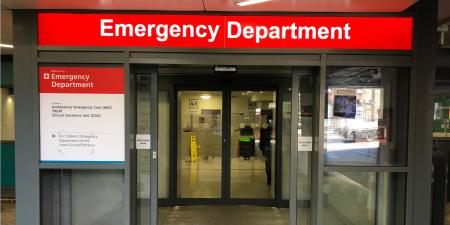Traumatic brain injury (TBI) is one of the leading causes of morbidity and mortality in young people in the U.S. [1]. It is estimated that TBI occurs in 1.5 million people each year. About 1.1 million are seen in emergency departments or clinics and then released; around 400,000 people with mild or moderate TBI are never seen by medical personnel; and another 235,000 must be hospitalized [2, 3]. Of the hospitalized, 50,000 die and 80,000 are left with permanent sequelae [2]. Falls account for about 28 percent of all TBI, followed by motor vehicle collisions at 20 percent and motor vehicle-pedestrian accidents at 19 percent. Assaults account for only 11 percent of TBI overall [4], although moderate and severe TBI in a child under the age of 4 is often secondary to child abuse. The risk of TBI is almost twice as great in males as in females. Those at greatest risk, however, are adolescents and young adults, aged 15 to 24 years, and children under age 4.
Traumatic brain injury has been defined in a variety of ways and is often used interchangeably with the term head injury. Both phrases refer to injuries caused by external forces to the head that lead to temporary or permanent impairments in brain function. Mechanisms for injury can be contact or inertial. Contact injuries occur when impact is delivered to the head at rest and results in skull fractures, epidural or subdural hematomas, and contusions, i.e., focal injuries. Inertial injuries occur when the head is set into translational or rotational motion, with or without a contact force, leading to a more diffuse injury. In both circumstances, injury occurs when these forces cause greater strain than the brain structure can tolerate. Brain injury can be subdivided into primary injury, which occurs immediately, and secondary injury, which begins right after the primary injury and may continue for an unpredictable length of time.
Primary Brain Injury
Primary injuries include skull fractures in the vault or basilar region, intracranial hematomas, contusions, and diffuse brain injury. Skull fractures are associated with hematomas, cranial nerve damage, and worsening of brain injury.
Subdural hematomas are most common, seen in 20-25 percent of all patients who become comatose following brain injury [5]. This type of hematoma is caused by the tearing of bridging veins over the cortex or the venous sinuses and is associated with a mortality rate of 40-60 percent in patients who require surgery [6]. Subdural hematomas are also regarded as one of the most characteristic central nervous system lesions encountered in shaken baby syndrome.
Epidural hematomas occur between the skull and the dura, typically after laceration of the middle meningeal artery. These are not as common as subdural hematomas and are usually seen in only 8-10 percent of comatose patients [7].
Duret hemorrhages, or hemorrhage in the pons or midbrain, usually occur as a result of herniation and typically result in death or a persistent vegetative state.
Contusions are punctuate (or capillary) hemorrhages, edema, and necrosis that originate in discrete regions and then coalesce with age to look more like intracerebral hematomas. Found in 20-25 percent of patients with severe TBI, contusions occur most often in the anterior temporal lobes and inferior frontal cortex due to shifting of the brain over the irregularly shaped skull in these regions [7]. Contusions are classified as either coup (injury to brain tissue under the point of impact) or contrecoup (injury to the brain opposite the site of impact occurring when the brain is in motion). Laceration or punctuate contusion at the gray-white junction, within the corpus collosum or brainstem is seen with diffuse axonal injury (DAI). Almost half of severe TBI patients and one-third of those who die have diffuse axonal injury. There is evidence that DAI may not be a primary injury, but may in fact fall into the secondary injury category [8].
Secondary Brain Injury
Within minutes of head trauma, cascades of destructive neurochemical, neuroanatomic, and pathologic processes begin, resulting in more severe brain injury. Circulation of excitatory amino acids including glutamate and aspartate increases significantly, leading to swelling and neuronal death. Elevated levels of extracellular potassium can cause cerebral edema and increased cytokines, producing more inflammation. As intracranial pressure increases, so does the severity of TBI. If the pressure exceeds 40 mmHg, cerebral hypoxia, ischemia, edema, hydrocephalus, and herniation can occur. Hypotension and hypoxia have been associated with greater morbidity and mortality; in fact, hypotension nearly doubles the mortality from TBI. It is these secondary injuries that predict the final outcome for the patient. Intracranial pressure from the processes just described, for example, causes compression of the brain that can produce supratentorial or cerebellar herniations.
Evaluation of Patients with TBI
Upon evaluation, patients with traumatic brain injury are placed in one of three categories; minor, moderate, or severe head trauma. This initial evaluation includes securing a patent airway and restoring normal respirations. Fluid resuscitation to maintain the systolic blood pressure above 90 mmHg is imperative to prevent hypotension that results in decreased cerebral perfusion, worsening cerebral ischemia, and increased mortality. All TBI patients should be treated as though they have a spinal fracture until it is determined that they do not. Patient status is assessed using the Glascow coma scale (GCS). Scores from the GCS's three component scales--speech (1-5), eye opening (1-4), and motor response (1-6)--are added together to provide a final score.
Minor TBI
Patients with minor head trauma have an isolated head injury and a GCS score of 14 to 15 [9]. Most patients with minor head trauma are asymptomatic when they arrive at the ED or urgent care facility. If symptoms are present, they are typically headache (most common), nausea, vomiting, disorientation, confusion, or amnesia. Although most of these patients generally do very well, 3 percent have sudden neurological deterioration [10]. Unfortunately, there is no good way to tell who will fall into this very small group of patients--some say any history of loss of consciousness is an indicator, others say it is the length of the loss of consciousness [9, 11].
The need for imaging in this group is also debated [11]. Is it helpful to image the patients, or is keeping them in the hospital overnight and watching them closely for signs of changes in their neurologic examination just as safe and effective? Neuroimaging is generally not indicated in sober, low-risk patients. Low-risk patients are those who are asymptomatic, uninjured, have a normal exam, and have a trivial mechanism of injury. Those with moderate risk--with initial GCS of 15, normal exam, brief loss of consciousness, vomiting, headache, and intoxication--should have a CT of the head or prolonged stay in the hospital for monitoring. High-risk patients have focal neurologic findings, asymmetric pupils, multiple traumas, initial GCS of 14 to 15, loss of consciousness, headache, nausea, vomiting, seizure, intoxication, and much more [12]. These patients should undergo CT scanning and inpatient monitoring. Most low-risk patients with minor head trauma can be safely discharged after the initial evaluation to be monitored by someone at home over a 4-6 hour period. If there are any concerns, or no one at home to monitor the patient, he or she should be kept for observation.
Moderate TBI
Patients with moderate TBI have a GCS score of 9 to 13 and a variety of symptoms. They often describe brief posttraumatic seizures, loss of consciousness, and confusion. The most challenging patient in this category is the one who arrives lucid and then rapidly declines. Around 75 percent of these patients have either subdural or epidural hematomas [13]. If caught early, they do well, but those with an initial GCS greater than 9 who deteriorate to less than 8 have worse outcomes than those with severe TBI (GCS less than 8) [14]. Diligence is the key to achieving the best outcome with these patients. They require close clinical observation, serial CT scans with changes in exam, and early neurosurgical intervention. If a neurosurgeon is not readily available, immediate intervention with hyperventilation and osmotic therapy should be initiated.
Severe TBI
Patients with a GCS less than 8, and any intracranial contusion, hematoma, or brain laceration have severe TBI. Prognosis is determined by papillary response, age, medical conditions, motor exam on arrival, and other injuries [15]. Around one-fourth of patients with severe TBI eventually require neurosurgical intervention for intracranial lesions [16]. Adult patients who survive severe traumatic brain injury (mortality is approximately 60 percent), are inevitably left with severe disability [17]. In children, the mortality is much lower, as is the likelihood of significant, permanent disability [18].
References
-
Marion DW. Trauma of the nervous system. Craniocerebral trauma. In: Bradley WG, Daroff RB, Fenichel GM, Jankovic J, eds. Neurology in Clinical Practice. 5th ed. Philadelphia, PA: Butterworth-Heinemann; 2008:1095.
-
Langlois JA, Rutland-Brown W, Thomas KE. Traumatic Brain Injury in the United States: Emergency Department Visits, Hospitalizations and Deaths. Atlanta, GA: Centers for Disease Control and Prevention, National Center for Injury Prevention and Control; 2006:1. http://www.cdc.gov/ncipc/tbi/TBI_in_US_04/TBI%20in%20the%20US_Jan_2006.pdf. Accessed July 16, 2008.
-
Langlois, 49.
-
Langlois, 11.
-
Marion, 1096.
-
Heegaard W, Biros M. Traumatic brain injury. Emerg Med Clin North Am. 2007;25(3):671.
-
Marion, 1097.
- Povlishock JT, Christman CW. The pathobiology of traumatically induced axonal injury in animals and humans: a review of current thoughts. J Neurotrauma. 1995;12(4):555-564.
- Servadei F, Teasdale G, Merry G. Neurotraumatology committee of the World Federation of Neurosurgical Societies. Defining acute mild head injury in adults: a proposal based on prognostic factors, diagnosis, and management. J Neurotrauma. 2001;18(7):657-664.
-
Heegaard, 661.
- Ingebrigtsen T, Romner B. Routine early CT-scan is cost saving after minor head injury. Acta Neurol Scand. 1996;93(2-3):207-210.
-
Heegaard W, 655-678, viii.
-
Heegaard, 667.
- Rockswold GL, Pheley PJ. Patients who talk and deteriorate. Ann Emerg Med. 1993;22(6):1004-1007.
- Seigel JH. The effect of associated injuries, blood loss, and oxygen debt on death and disability in blunt traumatic brain injury: the need for early physiologic predictors of severity. J Neurotrauma. 1995;12(4):579-590.
-
Cruz J. Severe acute brain trauma. In: Cruz J, ed. Neurologic and Neurosurgical Emergencies. Philadelphia, PA: WB Saunders; 1998:405-436.
-
Heegaard, 668.
- Feickert HJ, Drommer S, Heyer R. Severe head injury in children: impact of risk factors on outcome. J Trauma. 1999;47(1):33-38.



